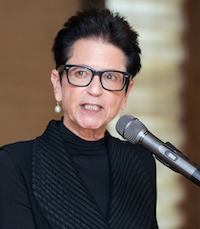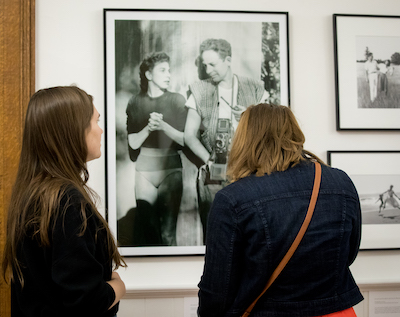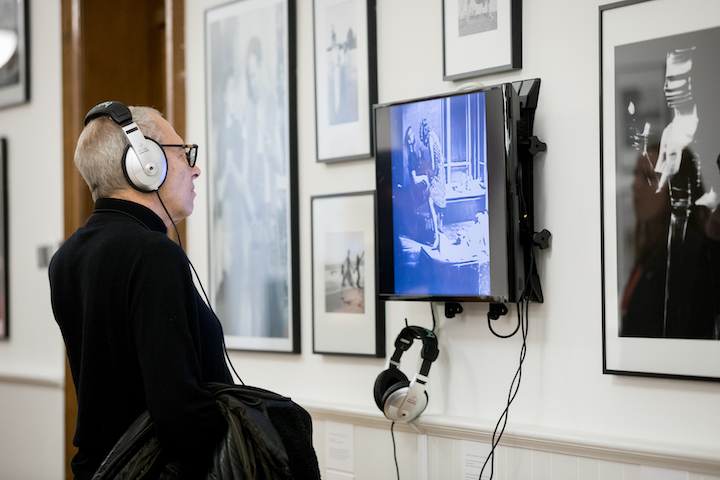The School of Education’s Dance Department on Oct. 12 opened a stunning permanent exhibition in Lathrop Hall’s new Gallery Space titled, “Radical Pedagogy: Margaret H’Doubler, Anna Halprin, and American Dance, 1916-Present.”

The exhibition was made possible via a generous donation from Jody Gottfried Arnhold (’65) and John Arnhold.
The photographs, visual art, and films that fill Lathrop’s Gallery Space bear witness to dance pioneer Margaret H’Doubler’s radical pedagogy and its inherently Midwestern progressivism — when dance became a rigorous academic discipline and the body became the route to scientific inquiry, self-discovery, creativity, and citizenship.
Items selected for the exhibition are drawn from numerous public and private collections that document H’Doubler’s continued influence across generations of dance artists.
“Margaret H’Doubler and her colleagues graduated many important artists,” said exhibition curator, Ninotchka Bennahum, a professor of dance studies and intellectual history at the University of California, Santa Barbara. “In 1926, she was the first to hone an academic curriculum for a BS in physical (dance) education and succeeded in extricating the study of dance from technique and creative practice only to dance education as a rigorous academic discipline.”
This, Bennahum said, “offered students a professional future in dance.”
That legacy is clearly demonstrated by three prominent dance artists, also featured in this exhibition, each of whom have mobilized H’Doubler’s radical pedagogy and made remarkable contributions to American cultural history: Anna Halprin (‘42), Mary Hinkson (’46, MS ‘47), and Matt Turney (’47).
Halprin invented the ordinary body and task-based improvisation as material for a dance, ushering in postmodernism. Hinkson and Turney, co-founders of the Wisconsin Dance Group (1947-1951), became the first black dancers to join the Martha Graham Dance Company.
Hinkson was one of Graham’s leading dancers while with the company. In 1960, she became the first African-American woman to perform for George Balanchine in roles he created for her at New York City Ballet, she also taught at Juilliard, the High School of Performing Arts and the Alvin Ailey American Dance Center.
Turney, who danced for Graham nearly two decades, was noted for her gift of stillness, which she demonstrated eloquently in Graham’s “Appalachian Spring.”

Professor Kate Corby, chair of the School of Education’s Dance Department who worked in consultation with Bennahum on the exhibition, said it is awe-inspiring to see the roots of dance in higher education — the UW-Madison’s dance legacy — in the halls of Lathrop.
“We are beneficiaries of H’Doubler’s bold, progressive initiative,” she said. “Every student who has had the opportunity to study dance in college has done so because of her groundbreaking work and we are grateful to Jody and John Arnhold for their generous gift, making this exhibition possible.”
Jody Arnhold (‘65), a dance advocate and educator, and founder of Dance Education Laboratory (DEL) at 92Y said that UW-Madison was the nation’s first program to offer a major in dance “against all odds.” Although she was an English major at UW, she said the dance program “inspired (her) to pursue a life in dance education” because her “heart was and is with H’Doubler and her understanding that dance is not just predetermined steps; it’s a philosophy, a history, and a way of teaching children to find the artist within.”
The exhibition is open to the public for viewing during regular Lathrop Hall building hours.
Exhibition Credits
Exhibition Curator: Ninotchka D. Bennahum, in consultation with Kate Corby
Photographic Curator: Ellen Crane
Installation Design and Graphic Art: Tim Laun, Scott Goodman, Rollin Fortier
Filmography: François Bernardi, NYPL – Lincoln Center
Film artist and performance historian: Douglas Rosenberg
Digital Media Installation: Paul S. Hundal, Adam Wiesenfarth, Lisa Marine, CAT Phan
Installation: Seth Klekamp
Digital Media Transfer: Boyd Hillestad
Printing: Star Printz
Framing: Paul Douglas
Acknowledgements
This exhibition would not have been possible without the vision and generous support of dance educator Jody Gottfried Arnhold (’65) and John Arnhold and the following people and institutions: Anna Halprin, Janet Eilber, Artistic Director, the Martha Graham Dance Company, the Faculty and staff of the Dance Department at UW-Madison, Amy Gilman, Director of the Chazen Art Museum, the University Archives of UW-Madison, the Wisconsin Historical Society, Linda Murray, Dance Curator and Arlene Yu, the Jerome Robbins Dance Division of the New York Public Library for the Performing Arts, Lincoln Center, the Museum of Art, Design, and Architecture at the University of California, Santa Barbara, Nicole Klanfer, Eric Mills, Irwin Appel and the Department of Theater and Dance, UCSB, and many students and artists involved in the re-staging of an excerpt from Anna Halprin’s Parades and Changes (1965). This exhibition would also not have been possible without the extraordinary scholarship of Sally Banes, Professor Emerita of Dance and Theater Studies and Chair of Dance (1992–1996) at UW-Madison, 1991-2003.
